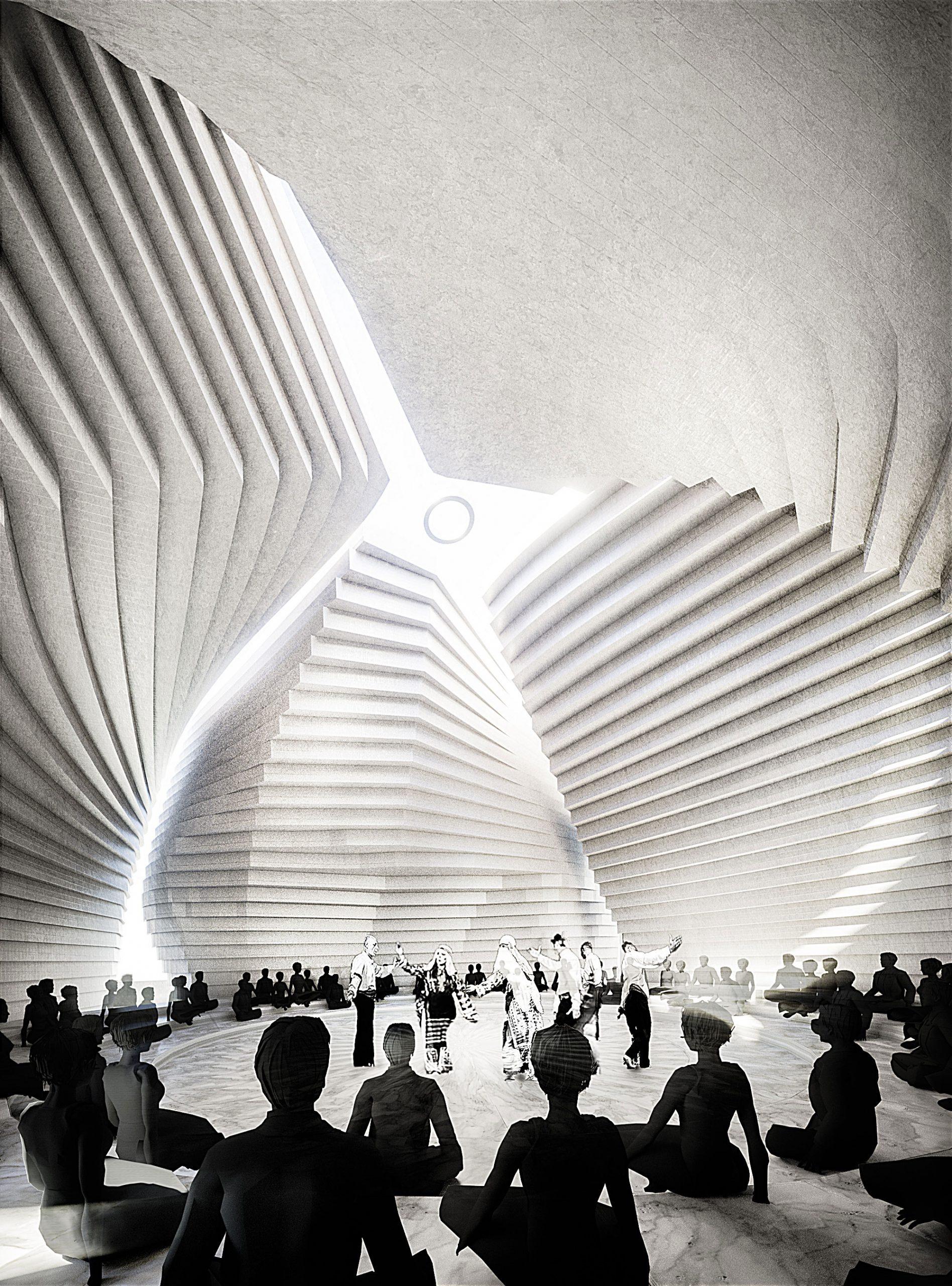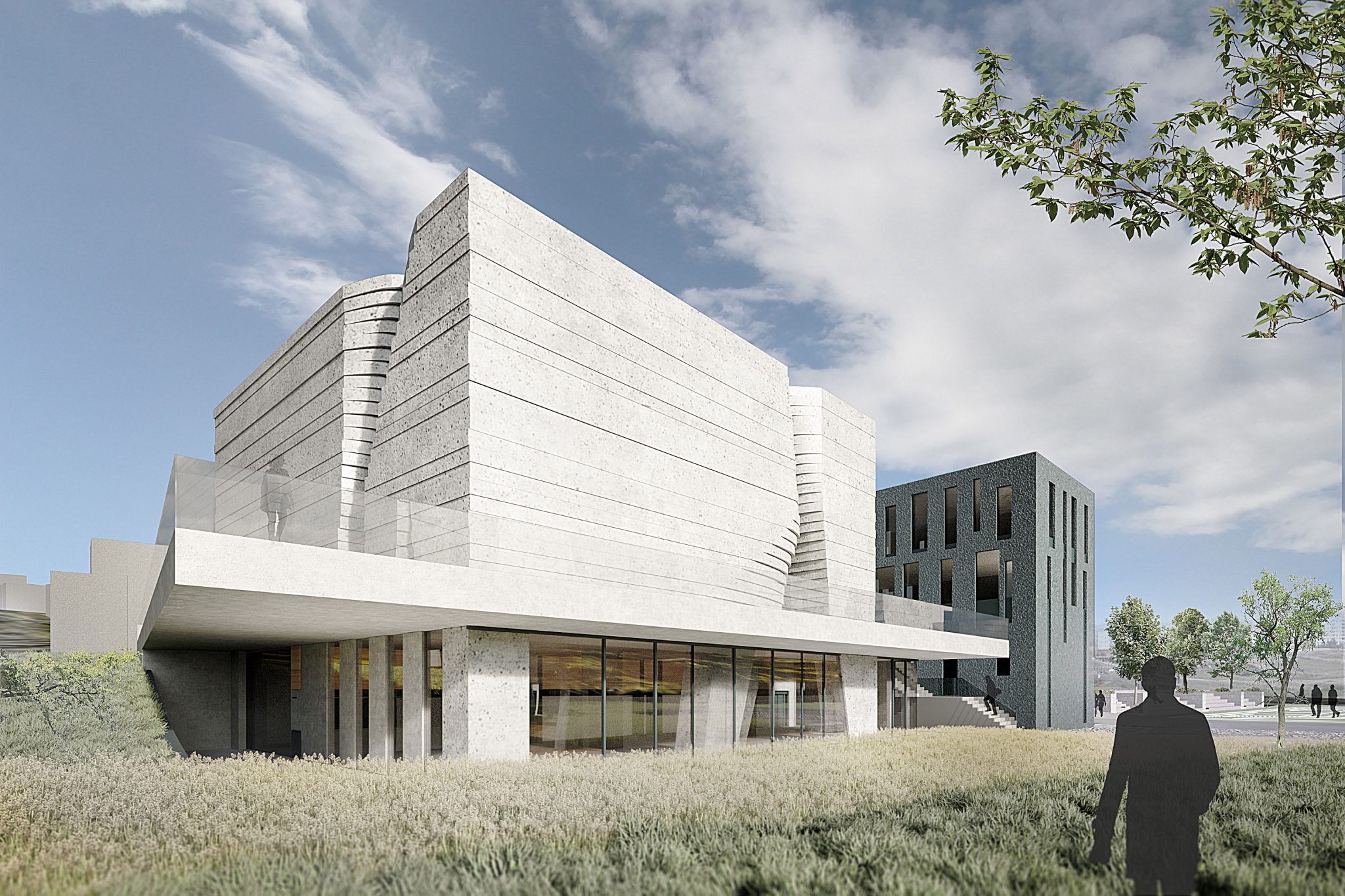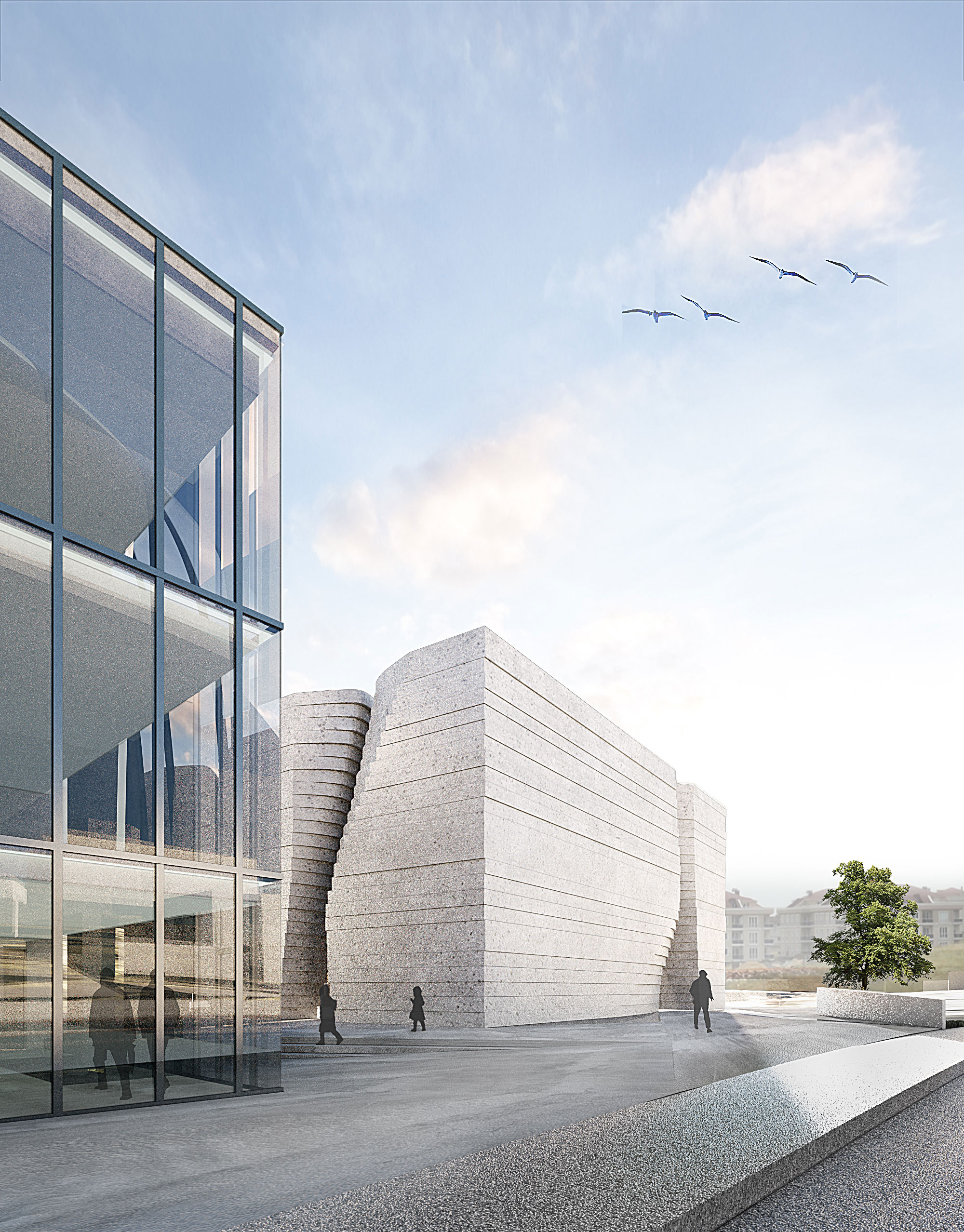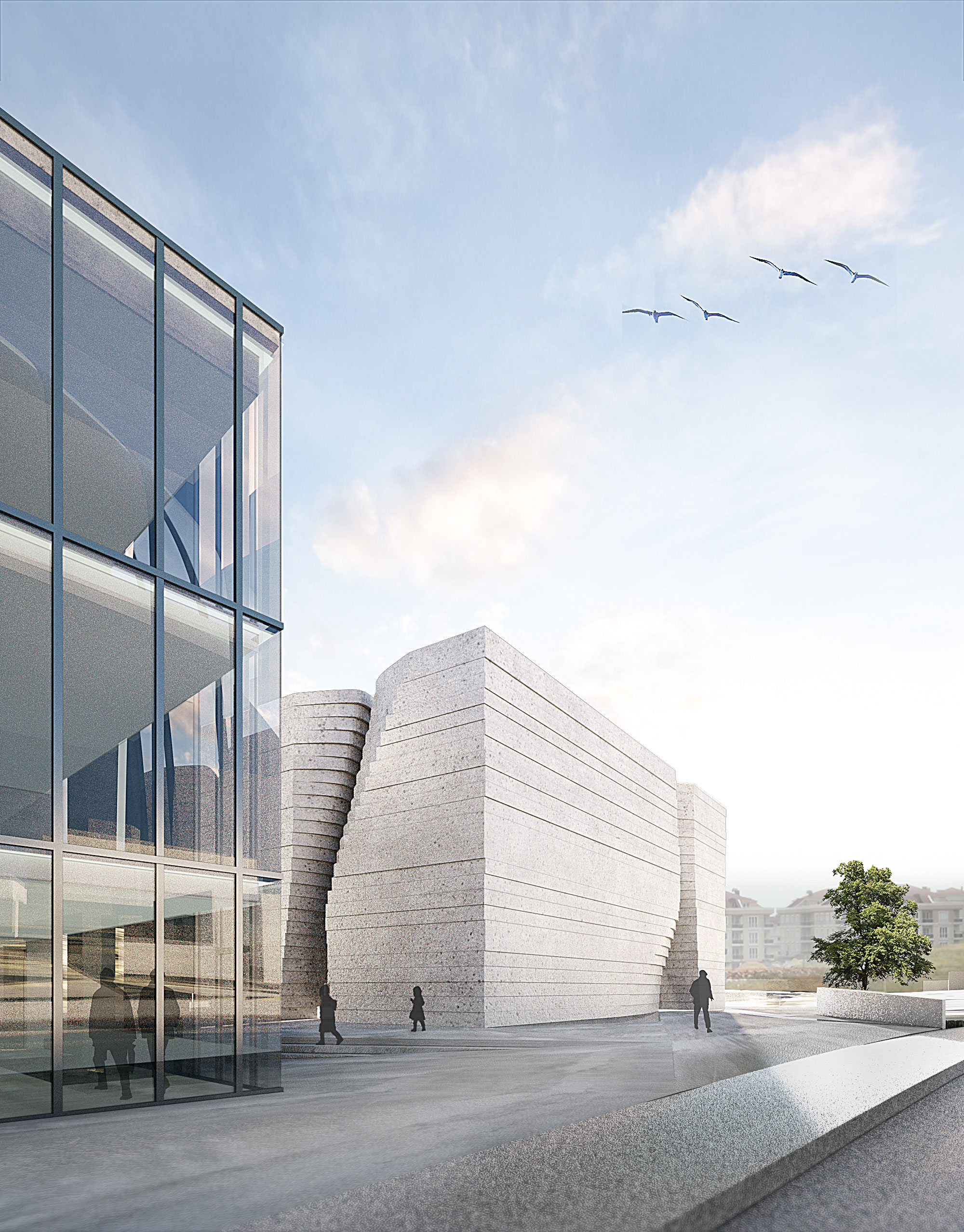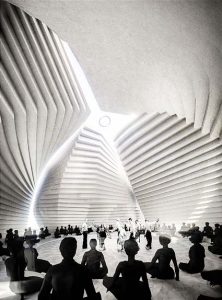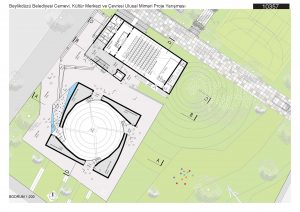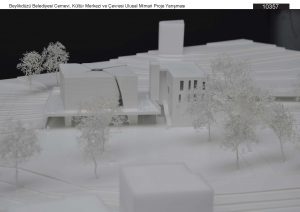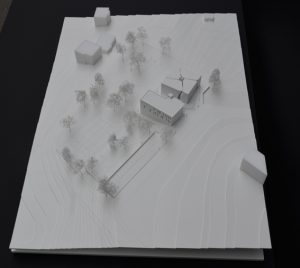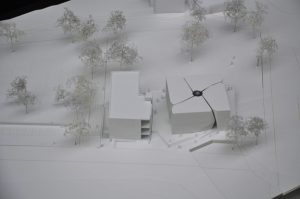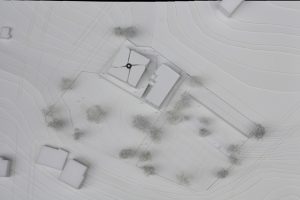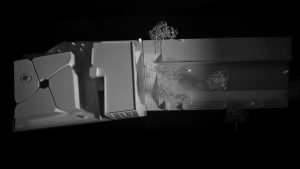Beylikdüzü Belediyesi Cemevi,
Kültür Merkezi ve Çevresi Ulusal Mimari Proje Yarışması
SESSİZ BİR VAROLUŞ’un 21. yy. Mekanı…
“Sessiz bir Varoluş” edilgendir. Mekana yansıması da sonuçları itibariyle hem edilgenliğin hemde bastırılan o kültürel geçmişin derin izlerini taşıyarak bugüne gelirken arkada bıraktığı izlerİ biriktirerek somutlaşacaktır.
Tüm Varlığı bir’de, tüm mekânı nokta’da, tüm zamanı o’nda görebilmektir
Alevilik, sürekliliğini evrensel insani değerler üzerinde var eden bir “duruş”un Anadolu’daki adı, Cem ise o duruş için varoluşun sessizliğinde kayboluştur. Bu sessizlik cem evlerinin ruhlarına asırlar boyu öyle işlemiştirki, bizler mimari olarak simgesellik, kamusallık, ikoniklik, seçilebilirlik, evrensel tanınabilirlik gibi kavramları konuşurken ‘o’ var olabilmeyi, herşeye rağmen var olabilmenin mücadelesini vererek bu yüzyıla gelebilmiştir.
21. yy mekanı ağlar ve kentler dünyasıdır. Bu proje dinin içindeki aleviliğin yerinden ziyade, 21. yy dünyasındaki dinin sosyal hayat içindeki yerini de sorgulayarak mekansal bir yoruma ulaşmayı hedeflemektedir. Burada amaç Aleviliği yorumlamaktan öte evrim sürecinde kesiklikler olan bir mabed türünü mekana oturtmanın meşruiyetini inşa etme çabasıdır. Diğer bir deyişle kültürel ve sözlü olarak gelişen bu ‘öz’ ün 21 yüzyıl mekanı ile tanışmasının sınırlarını ve içeriğini yeniden düşünen felsefenin arayışı olacaktır.
Yerelliğin önemini geriye itmeyen bir evrensellik arayışı ile şekillenecek olan bu inanç birimi yerelin kendi özeleştirisini de içeren bir bilinç felsefesi ile hayat bulmalıdır. Bunu hayata geçirecek mimari yapının temel ipuçlarıdır aslında bu projede sunulan.
İnanç felsefesi açısından ele almanın yanında kullanılan “4 kapı” şekli ve mekanı tanımlaması açısıdan günümüz sosyal kuramları ile 21. yüzyıl ibadet mekanın dış çeper/iç mekan algısının yeniden sorgulanmasını istemektedir. Diğer yandan tanımlı-tanımsız girişler ile varılan Cem alanı ise Tanrıyla buluşmanın metaforik mekanının/mekansızlığının ziyaretçide oluşturması arzulanan ilahi sırra özlemi olarak kurgulanmıştır.
CEM Meydanin’da Kutsallık Simgeleri:
1. Dört Kapı Kırk Makam Alevi –Bektaşi kültüründe inancın ve kemale ermenin aşamalarıdır.
Şeriat kapısı
Tarikat kapısı
Marifet kapısı
Hakikat kapısı
Her bir kapının onar adet makamı vardır. Kapıların fiziksel bir niteliği yoktur. Fiktif bir nitelik taşırlar ve evrenin dört kardinal yönünü simgelerler. Bazı ibadetlerde, bazı inananlar bu dört kapıya (yöne) selam verir.
2. Dar Meydanı ve Semah Alanı Her iki hizmetin de görüldüğü ortak alandır.
“Dar” Meydan’ın merkezindeki fiktif düşey eksendir ve özel bir kutsallık yoğunlaşmasına sahip olduğuna inanılır. Cem esnasında ritüel gereği Dede’nin karşısında dara duracak olanların bulunduğu alandır. Tüm cemaatin görebileceği merkez bir alandır. Bir ile on kişi arasında dara durmuş insanların durabileceği büyüklükte bir alandır. Dar meydanı semah alanı ile aynı yerdir. Semah öncesi ve sonrası kullanılır. Semahlar özgün hali ile ikişer kişilik, dörder kişilik guruplar halinde yapılır. Kalabalık halde toplu semahlar çok enderdir. Ancak, günümüz kent Alevi kültüründe bu sayı değişken olmakta, isteyen semaha kalkabilmektedir. Tüm cemaatin katıldığı toplu semahlar, oturdukları yerde ayağa kalkarak yapıldığı için meydanda olma zorunluluğu yoktur.
3. Post Alevilikte makamı temsil eder, yeri bellidir, değişmez, kutsallığı vardır. Post sayısı ve ismi farklı Alevi ve Bektaşi inançlarına göre değişir. En az 3 post vardır. Postların yeri kimi yerde güneye bakar kimi yerde ise önemsizdir. Ancak dedenin tüm cemaati kontrol edebileceği, giriş ve çıkışlarda dedeye yüz dönerek geri geri çıkılacak şekilde olmasına dikkat edilir.
4. Ocak Kutsallığı vardır. Soyun sürekliliğini simgeler. Sürekli yanık tutulması ve söndürülmemesi gerektiğine inanılır.
5. Kapı Tasavvufda kapılar açıldığı mekâna göre boyutlandırılır. Makamı yüksek olan mekânlara girilen kapılar alçaktır. Eğilip, selam vererek girmeyi sağlar. Kapı yanlarına niyaz edilir ya da öpülür. Kapıdan girerken, yüz dede ve post makamına dönük, kapıdan çıkarken ise yine, yüz dede ve post makamına dönük, geri geri çıkılır. Kapı önüne oturulmaz. Kapı önünde durulmaz.
6. Eşik Kutsallığı vardır. Bir âlemden başka âleme geçişi simgeler. Üzerine basılmaz. Eşiğe niyaz edilir ya da öpülür.
7. Çerağ Cem ayini esnasında ya da öncesinde özel bir ritüelle ve özel bir görevli tarafından yakılır. Cem ayini bittikten sonra yine bir ritüel ile söndürülür. Dedenin yanında özel bir yerde durur.
8. Cemaat Yerleşim Alanı Cem’lerde kadın, erkek ve çocuklar beraberdir. Kadın, erkek ayrımı olan alanlar yoktur. Bazen sembolik ayırımların olduğu alanlara rastlanmıştır. (Sağ-sol veya ön-arka gibi) ancak herhangi bir paravan, engel, sınır yoktur.
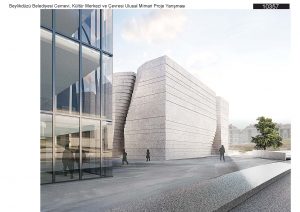
9. Teslim Taşı Bektaşiliğin ve Aleviliğin sembolü olan 12 köşe 12 imamları sembolize eder. Bektaşi şeyhleri ve babalarının boyunlarında sembol olarak bulunur. Dekoratif eleman olarak 12 köşe ve teslim taşı sembolleri pencere, duvar, yer kaplamaları gibi birçok yerde simgeleşerek kullanılır.
mit (Team): Mimar Mahsuni Söylemez, Yardimci: Irina Preda, Michael Bieglmayer (Blick 3d), Yuriy Pryveda Danisman: Emrah Söylemez, Statik: Hasan Olcay Koru,
„Beylikdüzü Municipality Cemevi, Cultural Center, and Surroundings National Architectural Project Competition. The Space of a Silent Existence in the 21st Century…
„A Silent Existence“ is passive. Its reflection on the space, in terms of its results, while carrying the deep traces of both passivity and the suppressed cultural past, will accumulate and materialize the traces left behind as it has come to the present day.
Being able to see all existence in one, all space in a point, and all time in it is Alevism’s name in Anatolia for a „stance“ that sustains its continuity on universal human values, and Cem is the disappearance of existence in the silence of that stance. This silence has been engraved in the souls of cemevis for centuries, such that while we discuss architectural symbolism, publicity, iconicity, selectability, and universal recognizability, „it“ has been able to survive, despite everything, by struggling to survive up to this century.
The 21st century space is a network and a world of cities. This project aims to reach a spatial interpretation by questioning the place of religion in social life in the 21st century, rather than the place of Alevism within religion. The goal here is not only to interpret Alevism, but also to construct the legitimacy of placing a shrine type with discontinuities in the evolution process into space. In other words, it will be the pursuit of a philosophy that rethinks the boundaries and content of this „essence,“ which has developed culturally and verbally, meeting with the 21st century space.
This belief unit, which will take shape with a universality search that does not push the importance of locality aside, must come to life with a consciousness philosophy that includes the locality’s self-criticism. These are actually the fundamental clues of the architectural structure that will put this into practice.
In addition to approaching it from a perspective of belief philosophy, the use of the „4 gates“ shape and the definition of space also demands a re-questioning of the outer perimeter/inner space perception of the 21st-century worship space with today’s social theories. On the other hand, the Cem area, which is reached by defined-undefined entrances, has been designed as the desire for the visitor to reach the metaphorical spacelessness of meeting with God as the divine secret.
Sacred Symbols in CEM Square:
- Four Gates Forty Ranks Alevi – Bektashi culture stages of faith and attainment. Sharia gate Tariqa gate Marifat gate Haqiqah gate Each gate has ten ranks. The gates do not have a physical nature. They carry a fictional quality and represent the four cardinal directions of the universe. In some worships, some believers give their greetings to these four gates (directions).
- Dar Square and Semah Area are common areas where both services are provided. The vertical axis at the center of „Dar“ Square is fictional, and it is believed to have a special sacred concentration. It is the area where those who will stand opposite the Dede during Cem rituals are located. It is a central area that the entire congregation can see. It is an area large enough for one to ten people to stand. Dar Square is the same place as the semah area. It is used before and after semahs. Semahs o…“
- „Dar Meydanı“ and „Semah Alanı“ are both seen as a shared space where both services take place. The „Dar“ Meydanı is the center of the vertical axis and is believed to have a special concentration of sanctity. During the ritual, the area where those who stand in front of the Dede are located. It is a central area that the whole congregation can see. It is an area where between one and ten people can stand. The „Dar“ Meydanı is the same place as the „Semah Alanı“ and is used before and after the Semah. Semahs are performed in their original form in groups of two or four people. Large group Semahs are rare, but in modern Alevi culture in cities, the number of participants can vary, and anyone who wishes to perform Semah can do so. Since collective Semahs are performed by standing up from their seats, there is no obligation to be in the square.
- „Post“ represents a place of authority that has a specific location, name, and sanctity that does not change. The number and name of the posts differ according to Alevi and Bektashi beliefs. There are at least three posts. The location of the posts is sometimes oriented towards the south, and sometimes it is insignificant. However, it is essential that the Dede can control the entire congregation, and when entering and leaving, people must face the Dede and leave the area backward.
- „Ocak“ has sanctity and symbolizes the continuity of the lineage. It is believed that it must be continuously burning and never extinguished.
- „Kapı“ (door) is scaled according to the importance of the place where it opens in Sufism. The doors that lead to places of higher importance are lower. One enters the door by bowing and greeting. The sides of the door are prayed or kissed. When entering the door, one must face the Dede and post position. When leaving the door, one must also face the Dede and post position, and leave the area backward. One does not sit or stand in front of the door.
- „Eşik“ (threshold) has sanctity and symbolizes the transition from one world to another. One does not step on it but prays or kisses it.
- „Çerağ“ (candle) is lit by a special ritual and a special person before or during the Cem ceremony. After the Cem ceremony, it is extinguished by another ritual and put in a special place next to the Dede.
- „Cemaat Yerleşim Alanı“ (congregation seating area) is where women, men, and children are together during Cem. There is no separation of areas for men and women. Sometimes, symbolic separations are seen (such as right-left or front-back), but there are no barriers, obstacles, or borders.
- „Teslim Taşı“ (the surrender stone) is a symbol of the 12 corners representing the 12 imams in Bektashism and Alevism. It is found as a symbol in the necks of Bektashi sheikhs and babas. As a decorative element, the 12 corners and surrender stone symbols are used in many places such as windows, walls, and floors.
The Cemevi is designed to accommodate both men and women, with no physical separation between the genders. The central space, known as the Cem, is where the congregation gathers for worship and communal meals. The Cemevi also features a Teslim Taşı, a decorative element symbolizing the 12 imams of Alevi belief. This symbol is often worn by Bektaşi sheikhs and babas, and is found throughout the CEM (Cemevi), including on windows, walls, and flooring.
It is worth noting that the Alevi community is a minority group within Islam, and their practices and beliefs differ significantly from those of mainstream Sunni and Shia Muslims. The Alevi faith places a strong emphasis on social justice, equality, and communal worship, which is reflected in the design of their places of worship, such as the Cemevi.
The Teslim Taşı, which translates to „Stone of Submission,“ is a symbol in both Bektaşi and Alevi traditions, representing the twelve Imams. It has twelve sides, each representing one of the twelve Imams, who are considered the rightful leaders of the Muslim community after the Prophet Muhammad. The Teslim Taşı is often worn by Bektaşi and Alevi leaders, such as şeyhs and babas, around their necks as a symbol of their authority and spiritual lineage.
In addition to its use as a personal emblem, the Teslim Taşı is also a decorative element used in various architectural and design contexts. It can be found as a symbol on windows, walls, and floor coverings, among other places. The twelve-sided shape of the Teslim Taşı is often incorporated into designs and patterns in Alevi and Bektaşi art and architecture.
